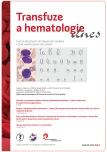Novelties in translational research of acute lymphoblastic leukaemia – selection from the European School of Haematology Conference
Authors:
N. Čuřík
Authors‘ workplace:
Ústav hematologie a krevní transfuze, Oddělení molekulární genetiky, Praha
Published in:
Transfuze Hematol. dnes,28, 2022, No. 2, p. 79-83.
Category:
Review/Educational Papers
doi:
https://doi.org/10.48095/cctahd2022prolekare.cz3
Overview
The article presents selected communications from the 2nd Translational Research Conference: Acute Lymphoblastic Leukaemia organized by the European School of Haematology. It focuses on the role of new molecular biology and genetic technologies in the recent significant advances in our understanding of the biology of acute lymphoblastic leukaemia and in the improvement of disease diagnostics, prognostics and therapy management.
Keywords:
acute lymphoblastic leukaemia – MRD – rearrangements
Sources
1. Machová Poláková K, Čuřík N, Votavová H, et al. 25 let vývoje metod molekulární biologie a jejich uplatnění v hemato (onko) logii. Transfuze Hematol Dnes. 2019; 25 : 34–42.
2. Čuřík N a Koblihová J. Vzdělávací workshop – uplatnění nových technologií v precizní medicíně CML a ALL. Transfuze Hematol Dnes. 2020; 26 : 66–69.
3. Starý J. Novinky v léčbě akutní lymfoblastické leukemie u dětí. Remedia. 2020; 30 : 62–64.
4. Vokurka S, Hugo J. Moderní molekuly v onkologii. Vydal Maxdorf s. r. o., Praha, 2019.
5. Büchler T a kol. Speciální onkologie. Vydal Maxdorf s. r. o., 2. vydání, Praha, 2020.
6. Chan LN, Murakami MA, Robinson ME, et al. Signalling input from divergent pathways subverts B cell transformation. Nature. 2020; 583 : 845–851.
7. Hurtz C, Chan LN, Geng H, et al. Rationale for targeting BCL6 in MLL-rearranged acute lymphoblastic leukemia. Genes Dev. 2019; 33 : 1265–1279.
8. Burt R, Dey A, Aref S, et al. Activated stromal cells transfer mitochondria to rescue acute lymphoblastic leukemia cells from oxidative stress. Blood. 2019; 134 : 1415–1429.
9. Arber DA, Orazi A, Hasserjian R, et al. The 2016 revision to the World Health Organization classification of myeloid neoplasms and acute leukemia. Blood. 2016; 127 : 2391–2405.
10. Lilljebjörn H, Henningsson R, Hyrenius-Wittsten A, et al. Identification of ETV6-RUNX1-like and DUX4-rearranged subtypes in paediatric B-cell precursor acute lymphoblastic leukaemia. Nat Commun. 2016; 7 : 11790.
11. McClure BJ, Heatley SL, Kok CH, et al. Pre-B acute lymphoblastic leukaemia recurrent fusion, EP300-ZNF384, is associated with a distinct gene expression. Br J Cancer. 2018; 118 : 1000–1004.
12. Gu Z, Churchman M, Roberts K, et al. Genomic analyses identify recurrent MEF2D fusions in acute lymphoblastic leukaemia. Nat Commun. 2016; 7 : 13331.
13. Li JF, Dai YT, Lilljebjörn H, et al. Transcriptional landscape of B cell precursor acute lymphoblastic leukemia based on an international study of 1,223 cases. Proc Natl Acad Sci U S A. 2018; 115: E11711–E11720.
14. Gu Z, Churchman ML, Roberts KG, et al. PAX5-driven subtypes of B-progenitor acute lymphoblastic leukemia. Nat Genet. 2019; 51 : 296–307.
15. Moorman AV, Schwab C, Winterman E, et al. Adjuvant tyrosine kinase inhibitor therapy improves outcome for children and adolescents with acute lymphoblastic leukaemia who have an ABL-class fusion. Br J Haematol. 2020; 191 : 844–851.
16. Cairo G, Leoni V, Conter V, et al. Relapses and treatment-related events contributed equally to poor prognosis in children with ABL-class fusion positive B-cell acute lymphoblastic leukemia treated according to AIEOP-BFM protocols. Haematologica. 2020; 105 : 1887–1894.
17. Brüggemann M, Kotrova M. Minimal residual disease in adult ALL: technical aspects and implications for correct clinical interpretation. Blood Adv. 2017; 1 : 2456–2466.
18. Kim IS. Minimal residual disease in acute lymphoblastic leukemia: technical aspects and implications for clinical interpretation. Blood Res. 2020; 55: S19-S26.
19. Kotrova M, Trka J, Kneba M, et al. Is next-generation sequencing the way to go for residual disease monitoring in acute lymphoblasticl? Mol Diagn Ther. 2017; 21 : 481–492.
20. Kotrova M, van der Velden VHJ, van Dongen JJM, et al. Next-generation sequencing indicates false-positive MRD results and better predicts prognosis after SCT in patients with childhood ALL. Bone Marrow Transplant. 2017; 52: 962–968.
21. Ruella M, Maus MV. Catch me if you can: Leukemia escape after CD19-Directed T cell immunotherapies. Comput Struct Biotechnol J. 2016; 14 : 357–362.
22. Kotrova M, Darzentas N, Pott C, et al. Next-generation sequencing technology to identify minimal residual disease in lymphoid malignancies. Methods Mol Biol. 2021; 2185 : 95–111.
23. Brüggemann M, Kotrová M, Knecht H, et al. Standardized next-generation sequencing of immunoglobulin and T-cell receptor gene recombinations for MRD marker identification in acute lymphoblastic leukaemia; a EuroClonality-NGS validation study. Leukemia. 2019; 33 : 2241–2253.
24. Cazzaniga G, De Lorenzo P, Alten J, et al. Predictive value of minimal residual disease in Philadelphia-chromosome-positive acute lymphoblastic leukemia treated with imatinib in the European intergroup study of post-induction treatment of Philadelphia-chromosome-positive acute lymphoblastic leukemia, based on immunoglobulin/T-cell receptor and BCR/ABL1 methodologies. Haematologica. 2018; 103 : 107–115.
25. Hovorkova L, Zaliova M, Venn NC, et al. Monitoring of childhood ALL using BCR-ABL1 genomic breakpoints identifies a subgroup with CML-like biology. Blood. 2017; 129 : 2771–2781.
26. Huang YJ, Kuo MC, Jaing TH, et al. Comparison of two quantitative PCR-based assays for detection of minimal residual disease in B-precursor acute lymphoblastic leukemia harboring three major fusion transcripts. J Mol Diagn. 2021; 23 : 1373–1379.
Labels
Haematology Internal medicine Clinical oncologyArticle was published in
Transfusion and Haematology Today

2022 Issue 2
Most read in this issue
- Importance of Down syndrome in haematology
- Mutations in epigenetic regulators – potential prognostic markers and therapeutic targets in acute myeloid leukaemia
- Novelties in translational research of acute lymphoblastic leukaemia – selection from the European School of Haematology Conference
- Real-world data on the efficacy and safety of ibrutinib and venetoclax in patients with chronic lymphocytic leukaemia, a single-centre experience
